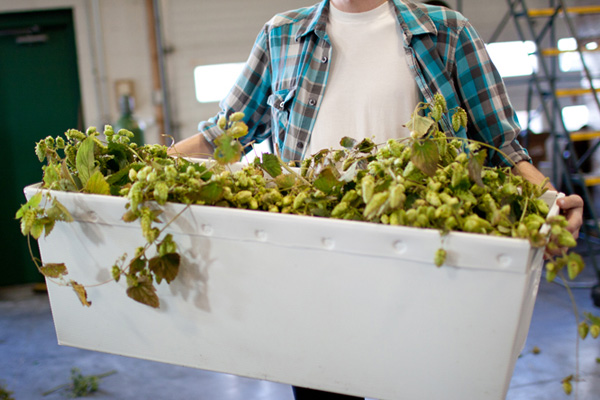
From late August through early November, along with fall colors, we begin to see fresh and wet hop beers on tap lines and in liquor stores. Fresh or wet hop beers are made with hops that have not been dried and pelletized. For brewers, this means either throwing down the cash to have hops flown in or harvesting a local hop supply; either way the beer is brewed with hops that have been picked off the vine within 24 hours of brewing.
Fresh hops can be used in any beer, but most brewers choose to use them in lighter-bodied brews like pale ales and IPAs because the light, round flavor isn’t lost in a heavy malt bill that can easily overpower the delicate flowers. The three key words, fresh, wet, and harvest, in theory refer to the same thing — the harvest of hops and their use when they are still fresh and wet (straight off the vine). In practice, however, the terms are slightly different.
Wet hops are by far the freshest, as they are still wet. Fresh refers to hops that have not been processed, but may be slightly less fresh than off-the-vine wet hops. And harvest is even more vague, referring to any beer made, or hops used, around hop-harvest time: Whether or not they are fresh or wet, we don’t know. That being said, many breweries use the terms interchangeably, although different degrees of hops freshness may be responsible for the range of flavors associated with these seasonal favorites. We tried a few of what the late season has to offer.
This year the fresh hop season has been longer than usual, but we are definitely not complaining. While the season usually runs from late August through the beginning of October, we’re finding the tail end of this year’s harvest, running through early November, to be providing some of the best and most diverse beers.
Summit’s Harvest Fresh IPA (Unchained Series Number 17) – available in 6-packs
Pouring a beautiful copper with solid carbonation, this brew is hoppier on the finish, rather than throughout the drinking experience, as most fresh-hopped brews tend to be. A little nutty, with a medium malt bill, it has a slight alcohol aftertaste that reminds you of its 7 percent ABV. Summit opted for hops sent in from the Yakima valley rather than choosing from the much-coveted and elusive local varieties, and this resulted in a piney, heavier flavor profile.

Brau Brothers’ Hundred Yard Dash – available in 6-packs
Called the Hundred Yard Dash due to the distance from the hop yard to the brew kettle, this limited edition brew is still made in Lucan, rather than at the brewery’s new locale, Marshall, Minn., because that’s where the hop farm remains. While a beer under the same name is brewed every year with the fruits of Brau Brothers’ labor, this year’s batch is citrusy with a deep, fruit nose. A rich, golden color and smooth mouthfeel is set off by an especially bitter, but not astringent finish.
Fulton’s Langola Wet Hop Ale – available only on tap
This straw-colored brew is named after the town in Wisconsin in which the hops were grown. With an ABV of 5 percent, the beer is light in body like Lonely Blonde, but hoppier on the front end like Sweet Child of Vine. This is the first year Fulton has made a wet hop beer – they have been growing hops for the last three, but this was the first time they had enough to use. Made with spelt instead of the usual wheat, it has a heavier mouthfeel and thicker head.
Town Hall Brewery’s Harvest Fresh Hop Ale (and Fresh Hop 100) – available only on tap
Town Hall Brewery has two fresh hop ales to offer us this time of year: the Fresh Hop 100 and its more adventurous younger brother, the Harvest Fresh Hop Ale. Based on the Fresh Hop 100, the offshoot has a slightly higher ABV at 5.9 percent (versus 5.6 percent) and a distinctive fruity nose and sweet profile throughout (without being saccharine), supported by the hoppy backbone. Boiled and aged with apples, the Harvest Fresh Hop Ale mingles flavors of oranges, apples and coriander. The Fresh Hop 100, on the other hand, is more rounded, with an overall bready mouthfeel.
Pro tip for local amateur hop growers: Make your own! Take your favorite IPA (homebrew or otherwise), and put it into your French press with a handful of your own hop harvest. Let sit for a few minutes and filter slowly, as you would coffee. Now you have your very own quick-and-dirty fresh hop beer.

Hey Liz, just a quick correction for ya. The Fulton Langola Fresh Hop Ale was named after the township in Central MN where th hop farm is located. Not Wisconsin. Also, and pretty minor, this was the second year of the hop farm, not the third. Cheers!